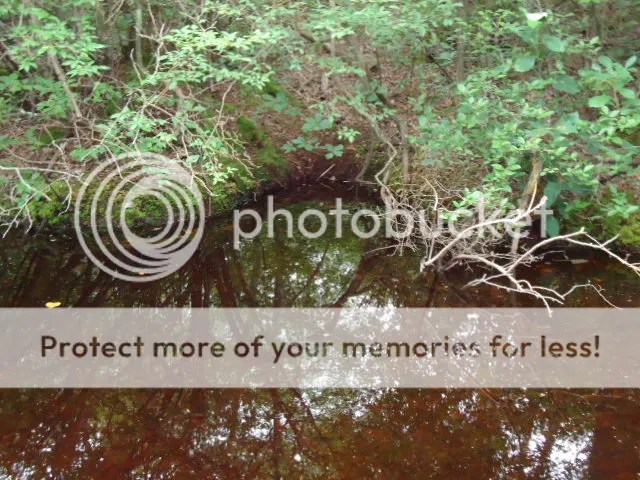In case you missed it, you can check out Part 1 here.
On Saturday morning, I awoke to bird calls and decent weather. The day’s breakfast would be a piece of the bannock I baked the evening before, cut in half and smeared with fresh blackberries gathered from around my camp.

After breakfast, it was time to explore the forest a little more. I soon discovered an area where stinging nettles were growing in abundance, so I stopped there and decided to try my hand at making cordage from the outer fibers of the stem, which I had not tried before. I cut a stem down near the ground, stripped off the prickles and leaves with my shirt and proceeded to peel the outer fibers off. Once the fibers were off the stem, I could work them into cordage.




Next up was some more forest exploration. Here you can see some birches just starting to change color:

I came across some yarrow along the little road:

This is the largest oak I could find on the property. I found larger ones elsewhere on the island, though.


And some alder trees (don’t know if they are gray or black alder):

Anyone know what this is?

Fresh tracks:




More tracks:

I wandered off the property and meandered along the dirt road toward the sea. Along the way, I finally saw a spruce:

Here’s a juniper, which is usually a common sight on Saaremaa:

And some cattails in a wet area:

More spruce:

Here’s the dirt road I was traveling on:

Someone recently had their forest thinned out a bit. This is a typical sight along forest roads in this part of the world.

As I neared the sea, I entered a slightly more developed area, where I snapped a picture of this idyllic cabin.

At the road running along the coast, I took a picture of this sign, which indicates that the sea is just a short walk away.

I saw a chestnut sapling along the way:
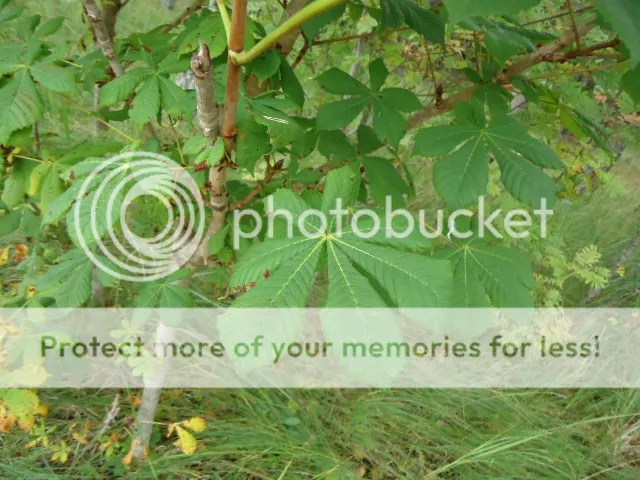
Almost there:

It took about 30 minutes to walk to the sea from my campsite. What you are looking at is the Baltic Sea, more specifically the Gulf of Riga. Latvia lies on the other side. The water was cold, so there was no way I would be going in. 🙂






After listening to the waves and breathing the sea air for a while, I walked back to the property I was camping on. I saw a large anthill in the pine forest on the way:

My “woodsman-sized hunger” was coming on strong, so I cut up the rest of the bacon I had, as well as some potatoes and onions, and lit up the buddy burner stove. Instead of making soup like the day before, I fried up the bacon and then added the potatoes, onions and a little salt and pepper.


While the stove was still lit, I threw on a kettle full of water to boil. Boiling water to make it drinkable (as opposed to using filters or chemicals) really isn’t that inconvenient. Each time after you cook a meal, just boil a bit of water before extinguishing your stove or fire. I do it almost automatically and I always have plenty of water to drink. A benefit of having at least one metal water container means that you can fill it with freshly boiled water right away without having to worry about heating the container too much (not a good idea with plastic containers).

Dessert was some delicious Finnish milk chocolate:

A little while after extinguishing the buddy burner stove, I realized there was a problem: I couldn’t get the cover/extinguisher off! The stove had gotten so hot from the long cooking session that the duct tape had shrunk! This didn’t happen the other times I tried it because the stove wasn’t as hot. Live and learn. 🙂 I think I will try aluminum tape on thin aluminum sheeting next time, instead of duct tape on aluminum foil. I managed to get the cover off after a while, but there was no way to get it back on.

I was getting low on good dry wood to burn, so I scouted around the forest for some new fuel. In no time, I found a dead standing rowan/European mountain ash with really nice solid and dry wood. Well, some of it was. Other bits were half-rotten and half-solid (but none of it was wet). I took all the good wood and some of the lower-quality stuff back to camp and split it up.

The next picture shows how I collected water from the drainage channels. I wrapped my kettle with my bandana and dunked it in. Then all that was needed was to pull out the bandana. It strained the water as it came out.

Later I came upon a mini-mushroom colony:

When dinner time came around, I made a platform from split wet birch I collected the day before, split up some of the rowan and made some kindling and shavings from it. I again lit some paper-thin birch bark with my ferro rod and got the fire going. As an aside, I normally like to use matches instead of a ferro rod, but matches, cigarette lighters etc. could not be brought on the airplane, and I didn’t have time to stop and get any before getting to camp the first evening. So my only means of making fire during this trip was two ferro rods/firesteels.

One thing I really like about having a small folding grill like this is that it’s very versatile. I can use it with a hobo stove, buddy burner or a plain old fire on the ground.

For dinner, or at least part of it, I wanted to try something I saw at the Scandic Woodsman Blog. I have to admit that I was a bit skeptical of this, considering the potential for extreme discomfort involved. What I would be doing is frying and eating stinging nettle leaves. I collected leaves from the nettle patch I had found earlier and threw them in a pan with some hot olive oil.

They shrank a lot while frying and when they were cooked through I sprinkled them with salt and pepper. Not my favorite meal, but not bad either. At least I didn’t end up with an unbearably itchy and swollen mouth and throat! After these fried nettle leaves, I ate some bannock and dried fruit.
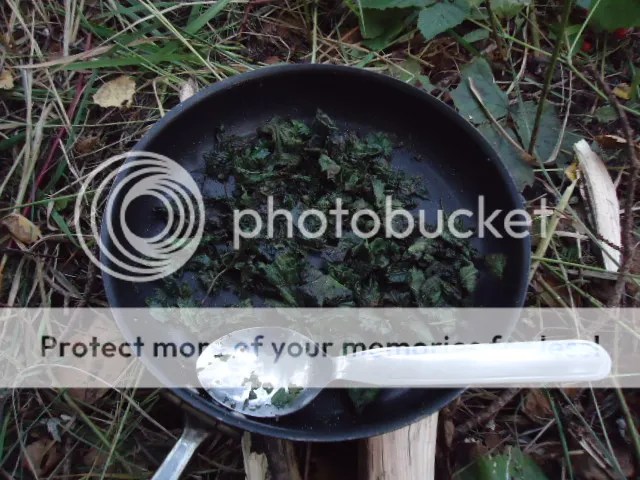
After taking the grill off the fire, I added some more wood. It was nice to keep the fire burning for a while, as it provided both light and warmth. I had plenty of wood on hand and really enjoy a good old campfire, so why not.


You can see in the picture above that I’m still using the tarp and bedroll for my shelter. Though it was raining on and off, it wasn’t cold or windy, so I didn’t really see a need to set up my poncho tent. A few mosquitoes and deer keds pestered me from time to time, but nothing requiring any kind of netting.
I stretched out on top of my bedroll and added new wood from time to time. Eventually, I crawled into my sleeping bag and drifted off.

I must have been snoring while I was asleep, because at one point during the night I was abruptly woken up by a curious moose not very far away from my camp! As for the exact distance, I can’t be sure, but let’s just say it was CLOSE! The moose’s calls scared the bejeebus out of me for a second, but once I had woken up a bit and realized what it was, I smiled. Luckily, there weren’t any more episodes like this for the rest of the night.
I woke up well rested on Sunday morning and, after eating the rest of the bannock from Friday evening, I decided it would be a good time to pick some blackberries to bring home to the family. I filled my canteen cup almost to the top, which is just under half a liter.
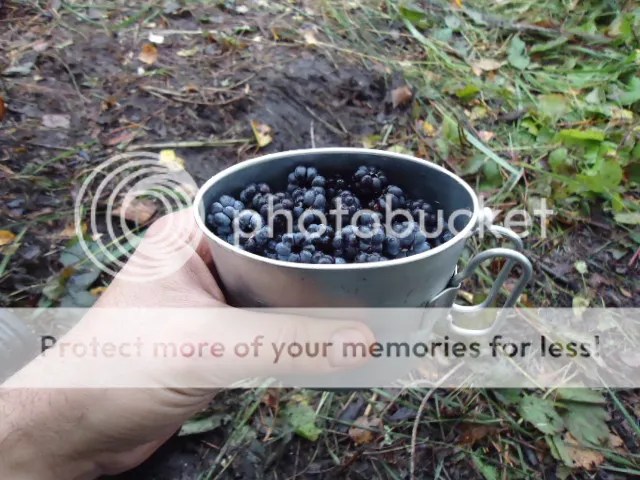
Though it was still morning, and my flight from the island wasn’t until almost 8 p.m., I knew that I had to start wrapping things up if I were to have enough time to visit town. So I spent several hours breaking camp, packing up and getting myself cleaned up, finally leaving the forest at about 2 p.m. I caught a bus to Kuressaare (cost all of 70 cents) after a 25-minute walk from my campsite and snapped these pictures.








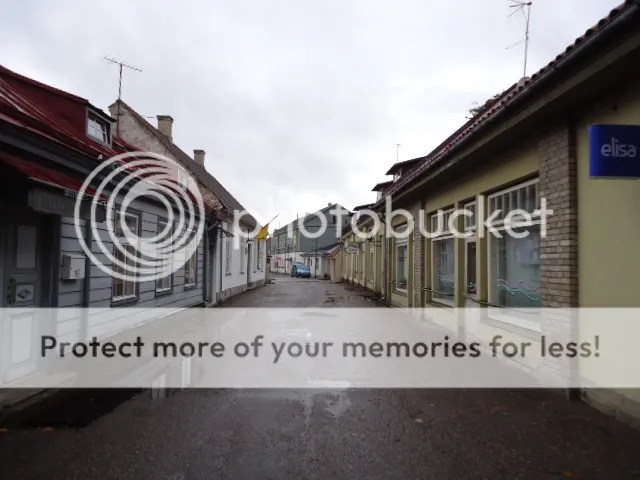

This is Kuressaare Fortress/Castle. It was built in the 1300s and is now a museum.







Knowing I still had a taxi ride, a flight, another taxi ride, a ferry ride and yet another taxi ride ahead of me, and that I wouldn’t be home until after 1 a.m., I decided to splurge and treat myself to a big restaurant meal at a place I had been to years earlier. This being Estonia, the bill ended up being very reasonable (maybe less than half of what it would have been in Finland).
I started with pelmeenid, which are small meat-filled fried pastries. Accompanying the meal was an Estonian pilsner.

Also enjoyed was some of the sweet dark bread typical of Saaremaa.

I was so eager to start eating that I only remembered part way through the meal to take a picture of the main course, which was a pork schnitzel, potatoes and salad.

For dessert, I enjoyed a deliciously creamy piece of cheesecake and a cappuccino. Hey, it can’t all be stinging nettle leaves and bannock! 😉

I was truly stuffed at this point and ready to head out. Thankfully, the rest of my trip home was uneventful, and I finally reached my doorstep, exhausted, a bit after 1 a.m.
This trip was a really nice opportunity to see something a bit different. As you probably guessed, I’m already dreaming about coming here again. Hopefully, a friend or two will accompany me next time!






























































































